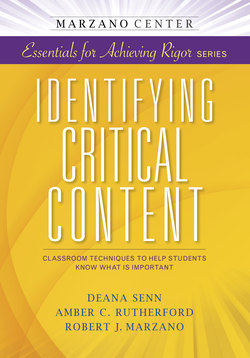Читать книгу Identifying Critical Content: Classroom Techniques to Help Students Know What is Important - Deana Senn - Страница 11
На сайте Литреса книга снята с продажи.
ОглавлениеInstructional Technique 1
VERBALLY CUE CRITICAL CONTENT
The easiest, and often fastest, way to communicate to your students that certain information is important is to tell them. That is the essence of verbal cueing. This sounds simple enough until you realize, after teaching a concept or skill, that your students’ questions indicate they do not understand what is important about the lesson even though you taught it. There is an effective way to convey critical information to students. This instructional technique, verbal cueing, will help you effectively implement the strategy of identifying critical content.
How to Effectively Implement Verbal Cueing
The effective execution of verbal cueing depends largely on the accurate identification of the important information in the content you are teaching. Use prioritized standards and learning targets to identify the critical content in a unit, lesson, and digestible bite of information. Use resources to ensure accuracy of the critical content, and then plan for how you will cue its importance to your students. Here are three ways you can verbally cue critical content.
Directly State the Important Information
Be direct, succinct, and assertive in stating the information that is important. If you feel overwhelmed by the amount of information you think should be included in your lesson, imagine how some of your students will feel. Take a moment to identify the central idea and a few supporting details, and work with that structure to determine how you will state which information is important.
Raise or Lower Your Voice to Indicate Critical Content
Students take cues from your intonation. Leverage that to signal to students what is important about the information you are imparting. Raise or lower your voice for a few sentences to help students focus on critical content. This may take practice; don’t hesitate to record yourself as part of learning to implement this technique.
Pause at Key Points During the Presentation
The simple act of pausing at key points during a presentation of new content gives students time to think about information and signal what they find to be important. This enhances their ability to identify the critical content in a lesson.
Common Mistakes
Learning from mistakes while trying to teach is often painful. Knowing ahead of time where problems might arise will increase your likelihood of success in implementing this technique. Watch out for these common mistakes when you use verbal cueing:
• The teacher has a difficult time isolating the critical content, which results in making general statements instead of cueing critical content.
• The teacher uses a verbal cue too frequently, causing students to feel confused and overwhelmed by the sheer volume of important information.
• The teacher might pause for emphasis too frequently or sustain the pauses for too long a time, leaving students unable to determine the critical content.
• The teacher inconsistently changes intonation and seems to signal that information is important when it isn’t.
Examples of Verbal Cueing in the Classroom
Following are two examples (one elementary and one secondary) and their corresponding nonexamples of verbal cueing. As you read, think about experiences you have had in your classroom. Consider the common mistakes and note how the example teachers cleverly avoid them and the nonexample teachers miss the mark by making one of these common mistakes.
Elementary Example of Verbal Cueing
